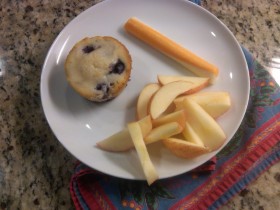 It’s morning… AGAIN! You’re running late and rushing to get on the road. You never question the importance of turning your car key in the ignition to get the motor running. So why would you ask your body to “back out” and get moving without starting its metabolic engine? The key to jump start your metabolism is breakfast – that simple morning meal that literally “breaks the fast.” Eating breakfast starts your body’s calorie-burning engine. Whatever fuel you put in your body the night before, it is either burned or stored by morning. Your fuel tank is on empty, but your energy demands are increasing from the minute your feet hits the floor. Don’t skip your daily opportunity to turn the key in your body’s ignition by eating a healthy breakfast!
It’s morning… AGAIN! You’re running late and rushing to get on the road. You never question the importance of turning your car key in the ignition to get the motor running. So why would you ask your body to “back out” and get moving without starting its metabolic engine? The key to jump start your metabolism is breakfast – that simple morning meal that literally “breaks the fast.” Eating breakfast starts your body’s calorie-burning engine. Whatever fuel you put in your body the night before, it is either burned or stored by morning. Your fuel tank is on empty, but your energy demands are increasing from the minute your feet hits the floor. Don’t skip your daily opportunity to turn the key in your body’s ignition by eating a healthy breakfast!
 Did you know that regular breakfast eaters have less difficulty maintaining weight? Make healthier food choices throughout the rest of the day? Have fewer afternoon cravings? Think clearer, and are more productive at work or school? So no more excuses! This March celebrate National Nutrition Month, by making time to kick start your metabolism with quality foods first thing. Slow to wake up? Start with these simple nutrient-rich food combinations:
Did you know that regular breakfast eaters have less difficulty maintaining weight? Make healthier food choices throughout the rest of the day? Have fewer afternoon cravings? Think clearer, and are more productive at work or school? So no more excuses! This March celebrate National Nutrition Month, by making time to kick start your metabolism with quality foods first thing. Slow to wake up? Start with these simple nutrient-rich food combinations:
- Try a cup of low-fat vanilla yogurt, raw almonds topped with fresh berries
- Pour a glass of milk and enjoy with peanut butter sandwich with raisins
- Crunch on whole grain cereal, low-fat milk and sliced banana
- Toast cheese on a small whole grain bagel and peel a fresh orange
As your body adjusts to morning fuel, your metabolism will too. Soon you will be able to whip up breakfast recipes with a smile on your face. Watch out! Your metabolism will be revved up; running, burning calories and ready to hit the road!
***
 Guest blog by Tammy Beasley, RD, CSSD, CEDRD.
Guest blog by Tammy Beasley, RD, CSSD, CEDRD.
Twitter: @TamBeasRD
Consultant, speaker, Spinning instructor, and registered dietitian, Tammy Beasley brings years of qualified experience to her work. She is a certified eating disorder registered dietitian (CEDRD) through the International Association of Eating Disorders Professionals since 1993, and was the first Alabama dietitian certified in sports dietetics with the American Dietetic Association in 2006. She is an active member of the Dean’s Advisory Board for the College of Human Sciences, Auburn University. She is the founder and creator of Rev It Up!, which originated in 2001 and has been or is currently offered in a class format in 25 states within the U.S.
Following her graduation with high honors from Auburn University and a dietetic internship with the University of Alabama in Birmingham (UAB), Tammy has been associated with some of the top health and wellness facilities in Miami, Florida, as well as Birmingham and Huntsville, Alabama. In 1995, she was selected Florida’s Recognized Young Dietitian of the Year for her work with her professional associations (President of the Miami Dietetic Association) and the Miami community. After moving back home to Alabama in 1998, Tammy has served as President of the North Alabama Dietetic Association and in various positions with the Alabama Dietetic Association, including media representative. Her work with the state culminated in her selection as Alabama’s Most Outstanding Dietitian in 2007 and Emerging Dietetic Leader in 2010. When she is not consulting, writing, or speaking on nutrition, she can be found on the ball field with her husband cheering for their two sons, Adam and Luke!
 Were you a part of the first MyPlate – YourPlate day on March 8th? Myplate-YourPlate day was designed to heighten public awareness around the importance of choosing nutritious foods for a healthy meal. The effort was supported by almost 6,000 of USDA’s MyPlate Community and National Strategic Partners, all of which are committed to promoting a diet reflecting the recommendations in the 2010 Dietary Guidelines for Americans and the new MyPlate food icon.
Were you a part of the first MyPlate – YourPlate day on March 8th? Myplate-YourPlate day was designed to heighten public awareness around the importance of choosing nutritious foods for a healthy meal. The effort was supported by almost 6,000 of USDA’s MyPlate Community and National Strategic Partners, all of which are committed to promoting a diet reflecting the recommendations in the 2010 Dietary Guidelines for Americans and the new MyPlate food icon.









